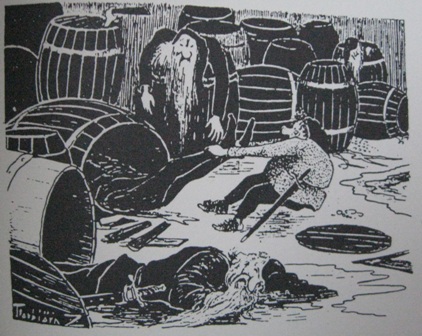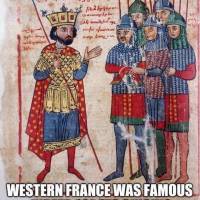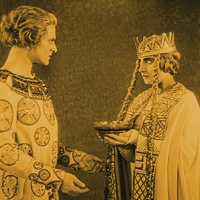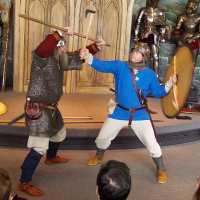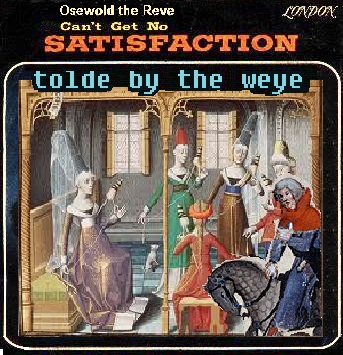
Though all of the pilgrims from Chaucer’s Canterbury Tales agreed that the Knight’s Tale (the first tale told in the tale-telling game) was of good moral substance – “In al the route nas ther yong ne oold / That he ne seyde it was a noble storie” (MiP l. 3110)[1] and they thought it was worth the while hearing it, “And worthy for to drawen to memorie” (MiP l. 3112)– we have to admit that it was a quite a long tale for one sitting. It had three intermissions!
So, to spice things up a bit and get the blood flowing in everyone’s limbs again, the Miller tells a dirty joke.
The party enjoyed his dirty little fabliau for the most part, “for the moore part they loughe and pleyde.” (ReP l. 3858) While everyone deserves to have a bit of fun on vacation, the fun on this vacation really should be of a wholesome nature – they were on a religious pilgrimage, after all. So it’s no surprise that a member of this party was offended.
There is plenty in the Miller’s tale for a devout Christian on religious pilgrimage to find offensive between making fun of a carpenter who is too easily convinced by a poor scholar to prepare for the end the world by “Second Flooding”, and, of course, the famously vulgar scene with a guy kissing a woman’s “nether yë.”
Surprisingly, Oswald the Reeve was the only member of the party offended by the Miller’s Tale, “Ne at this tale I saugh no man hym greve / But it were oonly Osewold the Reve.” (ReP ll. 3859-60) But, contrary to what we’d expect, it wasn’t satire on “rapture-fever” or even the lewd act in the story that offended the Reeve – no, it was all because John, the character who was duped in the tale, was a carpenter. And since Oswald the Reeve was a carpenter by trade, he saw the insult directed at someone of his profession to be an insult directed at him.
In retaliation, the Reeve tells a tale about a shifty Miller who is beat by two young scholars at his own game –stealing grain. That’s not all – the students cuckold the Miller and further humiliate him by deflowering his daughter.
This insult is just as revealing of Oswald the Reeve’s own personality as it is indicative of guild (or union) rivalries in 14th century England.
The Reeve taking insult and impulsively choosing to use his first tale in the tale telling competition to settle a score, as petty and counterproductive as it is, provides us a window into behavior that contributed to economic and social problems in Chaucer’s day.
It was also just some lighthearted competition between two tricksters for the amusement of everyone.
In the Miller’s Tale, Nicholas the clerk convinces John the carpenter that a great flood of Biblical proportions is coming. John imagines himself Noah and prepares for the deluge.
Chaucer references the tale of Noah’s Flood from the Biblical book of Exodus in his own comedy by way of its comedic Mystery Play. One of the most well-known Mystery (or Miracle) Plays is Noah’s Flood from the Chester cycle.
The Mystery Plays, just like Chaucer’s Canterbury Tales, were meant to entertain as well as morally instruct.
Chaucer introduces this method of storytelling when the host, Harry Bailey, announces the rules of the tale-telling game in The Canterbury Tales. In order to win a free supper paid at the expense of all of the other pilgrims, the pilgrim must tell the best tale that entertains as well as morally instructs:
“And which of yow that bereth hym best of alle,
That is to seyn, that telleth in this caas
Tales of the best sentence and moost solaas,
Shal have a soper at oure aller cost. ” (GP ll. 795-99)
Though Noah’s Flood carries a comedic tone throughout the entire play, the most familiar moments of comedy are the interactions between Noah and his wife.
Though Noah’s wife is more than willing to help her husband with the massive project of building the ark, even gathering an impressive group of animals:
“And here are beares, wolves sett,
Apes, owles, maremussett,
Wesills, squerrells, and fyrrett…” (ll. 173-72)[2]
…when it comes time to actually board the vessel, she takes the opportunity to remind Noah that he’s not the boss and that this is the last thing she wants to do:
“Yea, syr, sett up your seale
And rowe for the with eve!! hayle;
For withowten any fayle
I will not owt of this towne.” (ll. 197-200)[3]

This isn’t the first time the two have had a scuffle. Earlier in the play, we have a scene that could fit comfortably in The Honeymooners:
“In faith, Noe, I had as leeve thou slepte.
For all thy Frenyshe fare,
I will not doe after thy reade.” (ll. 99-101)[4]
Noah (Noe) responds to his wife’s disobedience by coolly asserting his authority:
“Good wiffe, do nowe as I thee bydd.” (ll. 102)[5]
Noah’s wife, isn’t having that:
“By Christe, not or I see more neede,
Though thou stand all daye and stare.” (ll. 103-4)
So Noah explodes into a rant about shrewish women:
“Lord, that weomen bine crabbed aye,
and non are meeke, I dare well saye.
That is well seene by mee todaye
in witness of you eychone.
Good wiffe, lett be all this beare
that thou makest in this place here,
for all the weene that thou arte mastere-
and soe thou arte, by sayncte John.” (ll. 105-12)[6]
Back in Chaucer’s day, guilds would produce and perform Mystery Plays for the amusement and spiritual enlightenment of the public during festivals. There was also an element of competition in the productions as well – each guild wanted to be recognized for putting on the best performance. It was a popular venue for competition between rival guilds.
So, by incorporating the Mystery Play, Chaucer is adding another layer to the rivalry between the Miller and Reeve pilgrims for the audience.
And, of course, since the Miller’s Tale is a tale within The Canterbury Tales – putting the carpenter in the tale of Noah’s Flood makes it a tale within a tale within a tale.

Beavis and Butt-head are amused to see poop coming from an ass of an ass in Beavis and Butt-head Do America. (image copyright 1996 MTV Productions/Paramount Pictures)
But let’s return to the Reeve’s comeback…
Symkyn, the main character in the Reeve’s Tale is a Miller. But he’s not just any miller – the Reeve adds a detail to his description of Symkyn to personalize his jab on the Miller pilgrim, Robyn.
The Reeve starts the description of the Miller character in his tale by pointing out that he can play the bagpipes, “Pipen he koude.” (ReT l. 3927) The Reeve’s “comeback” to the Miller pilgrim’s insult on carpenters is not only pointed at the Miller’s guild – but also directed personally at the Miller pilgrim because in the General Prologue, Chaucer mentions that the Miller pilgrim could blow and sound the bagpipes well, “A baggepipe wel koude he blowe and sowne.” (GP. l. 565)
Though the Reeve crafts his tale to get back at the Miller by repaying his insult to someone of his profession by mocking someone of the Miller’s profession – and points the jab at the Miller pilgrim himself, before he even starts telling the tale, he rambles on about what a drag it is getting old.
The Miller pilgrim is younger than the Reeve pilgrim because the Reeve pilgrim starts his comeback with something along the lines of, If I were a younger man, I’d teach you a real lesson:
“…ful wel koude I thee quite
with blerying of a proud milleres yë,
If that me liste speke of ribaudye.
But ik am oold, me list not pley for age…” (ReP ll. 3864-67)
But his rant isn’t exactly about that – he’s actually jealous of the Miller’s youth. The Reeve wants to be young again. He says that his body is old and that his grass time is done. The fresh, green grass of his youth is now dried forage and that the white hair on the top of his head shows everyone how old he is:
Gras tyme is doon, my fodder is now forage;
This white top writeth myne olde yeris;
Myn herte is also mowled as myne heris (RevP. ll.3868-70)
But he’s matured. He compares himself to “the medlar (tree), the fruit of which cannot be eaten until it has become mushy.”[7]
But if I fare as dooth an open-ers:
That ilke fruyt is ever lenger the wers,
Til it be roten in mullok or in stree.” (RevP. ll. 3868-73)
Now that he’s properly rotten, what is he ready for now? Has his wisdom ripened?
No, he continues by telling us that the four vices of old age are, boasting, lying, anger, and covetousness: “Avauntyng, liyng, anger, coveitise.” (RevP. l. 3884)
His talk isn’t about old and wise old men, but cranky old men who are sexually frustrated by being stuck in old bodies yet still having the desires of young men, or, as the Reeve puts it, a colt’s tooth, “yet ik have alwey a coltes tooth.” (RevP l. 3888)
The Reeve can’t get no satisfaction! It’s a good thing the Host stopped our Reeve’s rant on the sexual frustrations of old men and made him get on with telling his tale because it was getting creepy.
[1] References to Chaucer in Middle English are taken from Chaucer’s Major Poetry, Ed. Albert C. Baugh (New York, 1963).
[2] NeCastro, Gerard,“The Chester Cycle PLAY III (3) – Noah’s Flood,” From Stage to Page – Medieval and Renaissance Drama. Available online: http://machias.edu/faculty/necastro/drama/chester/play_03.html Accessed 01/20/2013.
[3] “Noah’s Flood”
[4] “Noah’s Flood”
[5] “Noah’s Flood.”
[6] “Noah’s Flood.”
[7] Editor’s comment. Chaucer’s Major Poetry, Ed. Albert C. Baugh (New York, 1963), 302.









